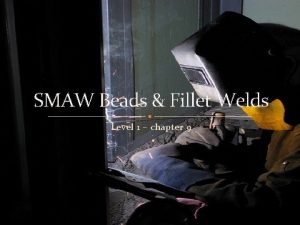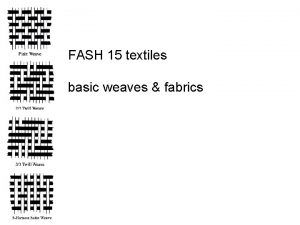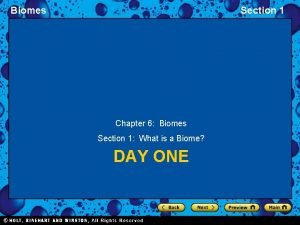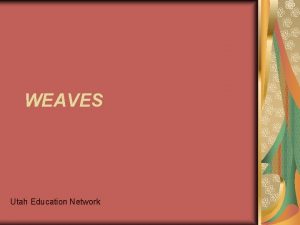WEAVES Weaves Plain Most simple and most common














- Slides: 14

WEAVES

Weaves Plain Most simple and most common type of construction Inexpensive to produce, durable Flat, tight surface is conducive to printing and other finishes Method of Construction: Each filling yarn goes alternately under and over the warp yarns Common Fabrics: Cotton calicos, cheesecloth, gingham, percale, voile Fashion Uses: Dress shirts, dresses, shawls & scarves

Weaves Basket A variation of the plain weave Usually basket or checkerboard pattern Contrasting colors are often used Inexpensive, less durable than plain weave Method of Construction: Two or more warps simultaneously interlaced with one or more fillings Common Fabrics: Oxford, Monks cloth Fashion Uses: Dress shirts, coats, backpacks

Weaves Twill Creates a diagonal, chevron, houndstooth, corkscrew, or other design The design is enhanced with colored yarn Is strong and may develop a shine Method of Construction: Three or more shafts; warp or filling floats over two or more counterpart yarns in progressive steps right or left Common Fabrics: Denim, gabardine, serge, tweed Fashion Uses: Jeans, Chino pants and coats, Kakhi’s

Weaves Satin Smooth, soft luster Excellent drapability Floats snag easily Method of Construction: Floats one warp yarn over four or more weft yarns, then tied down with one thread, resulting in a smooth face Common Fabrics: Satin, satin-weave fabrics out of fabrics such as cotton. Fashion Uses: Blouses, evening wear

Weaves Jacquard Yarns woven into unlimited designs, often intricate, multicolor effect Expensive, but the design doesn=t fade or wear out Durability depends on the fiber used The Jacquard loom was invented by Joseph Marie Jacquard Method of Construction: Warp is individually controlled with each pick passage creating intricate designs Common Fabrics: Brocade, damask, tapestry Fashion Uses: Dressy jackets, evening wear

Weaves Leno A mesh-like fabric Method of Construction: A pair of warp threads are passed over and under the filling yarns in a figure 8 or an hourglass twist, creating a geometric pattern Common Fabrics: Fashion Uses: Netting, shrugs

Weaves Knit Soft, stretchy Method of Construction: Interlooping yarns In weft knitting, loops are formed by hand or machine as yarn is added in crosswise direction. In warp knitting, loops are formed vertically by machine, one row at a time Common Fabrics: Jersey knit (single, plain), purl knit , rib knit, Interlock, double knit, raschel Fashion Uses: T-shirts, sports wear, dresses, panty hose, sweaters, swimwear, loungewear

Weaves Uncut pile Loops are possible on both sides of fabric Soft and absorbent, relatively inexpensive Can snag if loops are caught Method of Construction: Generally a plain or twill weave with a third dimension--additional warp yarn or filling yarn is introduced into the basic structure and forms a loop at regular intervals Common Fabrics: Frieze, terry cloth Fashion Uses: Robes, towels

Weaves Cut Pile Soft and warm, resilient, absorbent May have a nap that must be matched May be expensive and need professional cleaning Method of Construction: Similar to uncut pile, but loops have been cut Common Fabrics: Corduroy, velveteen Fashion uses: Pants, evening wear, lounge wear

Weaves Non-woven Does not have a distinct pattern Generally stiff and somewhat scratchy Method of Construction: Fibers are bonded by mechanical or chemical means Common Fabrics: Pelon Fashion Uses: Shape and stabilization of garments

Weaves Felt Soft, non-woven, can pull apart Method of Construction: Felting occurs when heat, moisture, agitation, and pressure applied to wool fibers, causing the fibers to interlock permanently. Common Fabrics: Felt Fashion Uses: Hats, costumes

Weaves Film Plastic-like material, repels liquid, stiff Mildews, rots, tears Inexpensive, fairly durable Method of Construction: Made from synthetic solutions formed into thin sheets Common Fabrics: Vinyl Fashion Uses: Raincoats

Weaves Laces and Nets Openwork fabrics Method of Construction: Yarns are knotted, twisted and/or looped. Common Fabrics: Lace Fashion Uses: Wedding dresses, children’s clothes, dressy outfits, handkerchiefs, costumes
 Procedure of stringer bead in flat position
Procedure of stringer bead in flat position Basic weaves
Basic weaves Ekg plain and simple answer key
Ekg plain and simple answer key Greatest common factor least common multiple
Greatest common factor least common multiple Common anode and common cathode
Common anode and common cathode Prime factors of 72
Prime factors of 72 What are the factors for 54
What are the factors for 54 Factors of 42
Factors of 42 Multiples of 9 and 21
Multiples of 9 and 21 Future simple examples
Future simple examples Chapter 6 biomes section 1 what is a biome
Chapter 6 biomes section 1 what is a biome Simple past simple present will future
Simple past simple present will future Past simple future simple
Past simple future simple Past continuous present simple
Past continuous present simple Present simple present continuous past simple
Present simple present continuous past simple
























